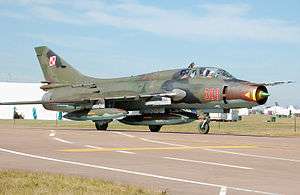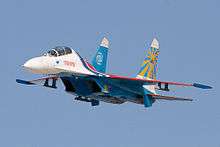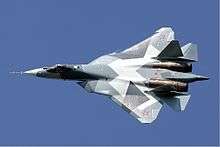Sukhoi
|
| |
| Division | |
| Industry | Aerospace and defense |
| Founded | as OKB-51, 1939 |
| Headquarters | Moscow, Russia |
Key people | Pavel Sukhoi, founder |
| Products |
Military aircraft Civil airliners |
| Revenue |
|
|
| |
|
| |
Number of employees | 26,177 (2011)[1] |
| Parent | United Aircraft Corporation |
| Website |
www |

Sukhoi Company (JSC; Russian: ПАО «Компания „Сухой“») is a major Russian aircraft manufacturer, headquartered in Begovoy District, Northern Administrative Okrug, Moscow,[2] and designs both civilian and military aircraft. It was founded by Pavel Sukhoi in 1939 as the Sukhoi Design Bureau (OKB-51, design office prefix Su).
Company history

After the collapse of the Soviet Union, each of the multitude of bureaus and factories producing Sukhoi components was privatized independently. In 1996, the government re-gathered the major part of them forming Sukhoi Aviation Military Industrial Combine (Sukhoi AIMC).[3] In parallel, other entities, including Ulan Ude factory, Tbilisi factory, Belarus and Ukraine factories, established alternate transnational Sukhoi Attack Aircraft (producing e.g. Su-25 TM).[3]
The Sukhoi AIMC comprises the JSC Sukhoi Design Bureau located in Moscow, the Novosibirsk Aviation Production Association (NAPO), the Komsomolsk-on-Amur Aircraft Production Association (KnAAPO) and Irkutsk Aviation. Sukhoi is headquartered in Moscow. Finmeccanica (since 2016, Leonardo-Finmeccanica) owns 25% + 1 share of Sukhoi's civil division.[4] The Russian government merged Sukhoi with Mikoyan, Ilyushin, Irkut, Tupolev, and Yakovlev as a new company named United Aircraft Corporation.[5] Mikoyan and Sukhoi were placed within the same operating unit.[6]
Sukhoi is also working on what is to be Russia's fifth-generation stealth fighter, the Sukhoi PAK FA. The maiden flight took place on the 29 January 2010.[7]
Usage
Sukhoi's Su-24, Su-25, Su-27, Su-30, Su-34, Su-35 and shipborne Su-33 aircraft are in service with the Russian Air Force and Navy as well as foreign armies. The Su-25 is the oldest Sukhoi still in production. Sukhoi attack and fighter aircraft have been supplied to Armenia, India, China, Poland, the Czech Republic, Iraq, Slovakia, Hungary, Georgia, East Germany, Syria, North Korea, Vietnam, Malaysia, Afghanistan, Yemen, Egypt, Libya, Iran, Angola, Ethiopia, Peru, Eritrea, and Indonesia. Venezuela signed contracts for the purchase of 30 Su-30 fighter jets in July 2006. More than 2,000 Sukhoi aircraft were supplied to foreign countries on export contracts. With its Su-26, Su-29 and Su-31 models Sukhoi is also a manufacturer of aerobatic aircraft.
U.S. sanctions
On August 4, 2006, the U.S. State Department imposed sanctions on Sukhoi for allegedly supplying Iran in violation of the United States Iran Nonproliferation Act of 2000. Sukhoi was prohibited from doing business with the United States Federal Government.[8] In November 2006, the U.S. State Department reversed its sanctions against Sukhoi.[9]
Civilian aircraft
In September 2007, Sukhoi launched its first modern commercial regional airliner—the Superjet 100, a 78 to 98 seater, built by Sukhoi. It was unveiled at Komsomolsk-on-Amur.[10] The maiden flight was made on May 19, 2008.[11]
Production aircraft
- Su-2: 1937, light bomber aircraft
- Su-7: 1959, "Fitter A", ground-attack aircraft
- Su-9: 1959, "Fitter B", interceptor fighter aircraft (nearly identical to the MiG-21 in appearance)
- Su-11: 1964, "Fitter C", interceptor fighter aircraft
- Su-15: 1965, "Flagon", interceptor fighter aircraft
- Su-17/Su-20/Su-22: 1970, "Fitter D" variable-wing ground-attack aircraft
- Su-24: 1970, "Fencer", jet bomber, variable-wing attack aircraft
- Su-25: 1975, "Frogfoot", ground attack aircraft
- Su-26: 1984, single seat aerobatic aircraft (civil)
- Su-27: 1977, "Flanker", air superiority fighter
- Su-29: 1991, double seat aerobatic aircraft (civil)
- Su-30: 1993, "Flanker C", multi-role strike fighter aircraft
- Su-31: 1992, single seat aerobatic aircraft (civil)
- Su-33: 1987, "Flanker D", carrier-based multi-role fighter aircraft
- Su-34/Su-32: 2006, "Platypus", Strike-fighter aircraft
- Su-27M/Su-35: 1995, "Flanker E", air superiority fighter aircraft
- Su-35BM: 4++ generation multi-role fighter aircraft
- Su-80: a twin-turboprop STOL transport aircraft
- Superjet 100: 2008, regional jet

 Decommissioned Polish Su-20 (export version of Su-17)
Decommissioned Polish Su-20 (export version of Su-17).jpg)

- Superjet 100 RJ
Experimental aircraft

- Su-1/I-330: 1940, high-altitude fighter
- Su-3/I-360: 1942, improved Su-1
- Su-5/I-107: jet-propeller fighter
- Su-6: 1942, ground attack aircraft
- Su-8/DDBSh: 1943, ground attack aircraft
- Su-9: jet fighter
- Su-10: jet bomber
- Su-12: observation plane (1947)
- Su-15: interceptor fighter
- Su-17: fighter
- Sukhoi-Gulfstream S-21: a supersonic business jet design.
- Sukhoi KR-860: doubledeck superjumbo jet design.[12]
- Su-37 ("Terminator"): an improved Su-35
- Su-28/Su-25UB: trainer and demonstrator
- Su-25TM/Su-39: 1984, ground attack aircraft, optimised for anti-tank use
- Su-38: light agricultural aircraft
- S-32/37: multirole fighter (was marketed for a time under the designation Su-47)
- Su-47: experimental aircraft
- P-1: 1958, interceptor fighter
- T-3: 1956, fighter
- T-4/100: 1972, supersonic bomber, similar in concept to XB-70 Valkyrie, which was developed by Sukhoi during the 1960s and 1970s.
- T-60S: intermediate range bomber.
- Sukhoi T-50/PAK FA: fifth generation fighter. Basic future aircraft of Russian Frontline Aviation. Maiden flight January 29, 2010.[13]
- Sukhoi/HAL FGFA: FGFA is a derivative project from the PAK FA being developed by the Sukhoi OKB and HAL for the Indian Air Force (FGFA is the official designation for the Indian version).
Planned aircraft
Note: The Sukhoi OKB has reused aircraft designations, for example: the Su-9 from 1946 and the later Su-9 from 1956, the former was not produced in quantity. Sukhoi prototype designations are based on wing layout planform. Straight and swept wings are assigned the "S" prefix, while delta winged designs(including tailed-delta) have "T" for a designation prefix.
Unmanned Aerial Vehicles
- Sukhoi Zond-1
See also
References
- 1 2 3 4 "Sukhoi annual financial 2011 report (in Russian)" (PDF). Retrieved 12 January 2015.
- ↑ "Contacts : Sukhoi Company (JSC)." Sukhoi. Retrieved on 17 December 2010. "23B, Polikarpov str., Moscow, 125284, Russia, p/b 604." (Direct link to map) – Address in Russian: "125284, Россия, Москва, ул. Поликарпова д. 23Б, а/я 604" (Direct link to Russian map)
- 1 2 Austin, Greg (2000-07-14). The Armed Forces of Russia in Asia. pp. 291–292. ISBN 9781860644856.
- ↑ "Finmeccanica Will Buy 25% of Sukhoi Civil Aircraft." Bloomberg.com. February 21, 2006.
- ↑ "Russian Aircraft Industry Seeks Revival Through Merger". The New York Times. February 22, 2006.
- ↑ Su-35 "In Parallel" With PAK-FA Archived March 21, 2010, at the Wayback Machine.
- ↑ Venäjällä esiteltiin uusi hävittäjäkone | Ulkomaat | YLE Uutiset | yle.fi
- ↑ "Russia slams U.S. sanctions on Russian arms companies". People's Daily Online. 2006-08-05.
- ↑ US lifts sanctions on jet maker Sukhoi – World – GMA News Online – Latest Philippine News
- ↑ Reuters, PREVIEW-Russia eyes new aviation glory with Superjet
- ↑ Russian News and Information Agency
- ↑ KR-860 Ultraheavy transport and passenger aircraft.
- ↑ Russian fifth-generation fighter jet takes to the air. Retrieved: 12 July 2011.
External links
| Wikimedia Commons has media related to Sukhoi. |
- Company website (English)
- www.sukhoi.ru—Other sources
- Sukhoi pages—Russian Aviation Museum
- Опытно-конструкторское бюро Сухого @biograph.ru (Russian)
- "Russian plane firm challenges West" by Jorn Madslien, BBC News
